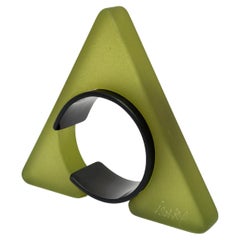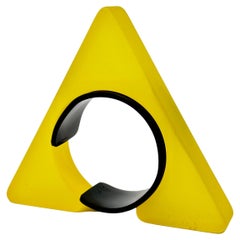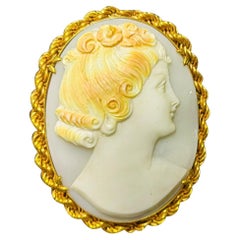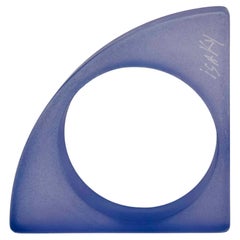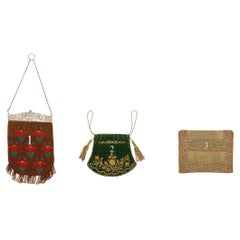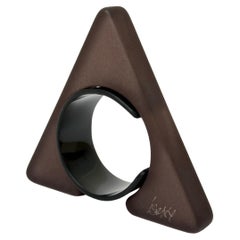European Collectible Jewelry
to
106
566
290
876
35
23
154
91
51
44
38
28
9
8
6
5
5
2
2
1
31
188
657
58
144
263
168
17
13
16
20
26
33
46
64
44
13
727
253
245
135
81
934
387
303
254
127
934
931
931
48
30
20
13
10
Place of Origin: European
Spectacular Geometric Cuff, Isaky, Paris c. 1980
By Isaky
Located in St Ouen, FR
Half object, half jewel this sculptural bangle is composed of two parts ; a sand blasted resin triangle and an acrylic bracelet allowing the cuff to be closed.
Both parts bear the ha...
Category
1980s Space Age Vintage European Collectible Jewelry
Materials
Resin
Spectacular Geometric Cuff, Isaky, Paris c. 1980
By Isaky
Located in St Ouen, FR
Half object, half jewel this Sculptural bangle is composed of two parts ; a sand blasted resin triangle and an acrylic bracelet allowing the cuff to be closed.
Both parts bear the ha...
Category
1980s Space Age Vintage European Collectible Jewelry
Materials
Resin
Important Pendant In Yellow Gold Cameo Old "Oval" pendant in 18k 20th Century
Located in Madrid, ES
Important Pendant In Yellow Gold Cameo Old "Oval" pendant in 18k set with claws decorated with a shell cameo representing the profile of a young woman. Weight: 25.5g Dimensions: 5x...
Category
Early 20th Century Art Nouveau European Collectible Jewelry
Materials
Gold
Spectacular Geometric Cuff, Isaky, Paris c. 1980
By Isaky
Located in St Ouen, FR
Half object, half jewel, this sculptural bangle in sandblasted resin bears the handwritten signature of the artist.
Measurements (cm) :
triangle's sides 9...
Category
1980s Space Age Vintage European Collectible Jewelry
Materials
Resin
Evening Bags
Located in Alessandria, Piemonte
Choose among three evening bags: the price is the same for everyone.
1) Chestnut brown jais sweater, with red and green flowers; silver metal closure with double opening; Liberty per...
Category
Mid-20th Century Hollywood Regency European Collectible Jewelry
Materials
Silver Plate
$353
Spectacular Geometric Cuff, Isaky, Paris c. 1980
By Isaky
Located in St Ouen, FR
Half object, half jewel this sculptural bangle is composed of two parts ; a sand blasted resin triangle and an acrylic bracelet allowing the cuff to be closed.
Both parts bear the ha...
Category
1980s Space Age Vintage European Collectible Jewelry
Materials
Resin
Geometric Cuff, Isaky, Paris c. 1980
By Isaky
Located in St Ouen, FR
Methacrylate plate fixed by a rubber link on a black acrylic bracelet, matt exterior and glossy interior, locked by an altugas rod wearing the Artist's brand.
Both the facade and th...
Category
1980s Space Age Vintage European Collectible Jewelry
Materials
Plastic
Hermès Paris, "La Promenade De Longchamps" Square in Printed Silk
By Hermès
Located in Madrid, ES
Description
HERMÈS Paris,
"La Promenade de Longchamps" square in printed silk
twill Square in silk twill printed on a light yellow ba...
Category
21st Century and Contemporary Modern European Collectible Jewelry
Materials
Silk
Gold Clasp for Necklace with Caucasian Carpet Symbol
Located in Alessandria, Piemonte
G/414 - Italian gold clasp for necklace with symbol of Caucasian carpets: unique piece specially made in Valenza, the famous "city of gold" , for ...
Category
1990s Other European Collectible Jewelry
Materials
Gold
Georgian Circa 1790 Italian Grand Tour Micro Mosaic Lady Bird 22 Carat Ring
Located in Lowestoft, GB
Georgian micro mosaic, late eighteenth century circa 1790, finely modelled as a ladybird, set into an octagonal goldstone.
The gold mount echoes the octagonal shape of the goldstone...
Category
Late 18th Century Grand Tour Antique European Collectible Jewelry
Materials
Gold
21st Century Santa Decoration Ball in Red by Venini
By Venini
Located in murano, IT
SANTA 199.05 Ø10 RV BALLOTON
Additional Information:
Material: Glass
Color: Red with gold leaf
Dimensions: Ø 10 cm
Available in other color options: Red with gold leaf
Category
21st Century and Contemporary European Collectible Jewelry
Materials
Glass
Jean Mégard, Ceramic Medallion, Biot c. 1950
By Jean Mégard
Located in St Ouen, FR
Extremly rare ceramic medallion depicting a stylised female figure.
Rich glazes with a juxtaposition of green and brown colours.
The piece is in very good condition for its age, j...
Category
1950s Mid-Century Modern Vintage European Collectible Jewelry
Materials
Ceramic
Earrings Acquamarina and Garnet on Gold
By Mitzi Saida Neri
Located in Alessandria, Piemonte
Elegant Italian earrings in garnet and aquamarine, mounted on gold. Unique pieces made by an Italian artist - Wonderful for the summer nights and also perfect for the Christmas time...
Category
Late 20th Century Anglo Raj European Collectible Jewelry
Materials
Gold
$1,415 / set
19th Century Binocle or Face to Hand in Gold
Located in Marseille, FR
19th century Binocle or hand face in gold.
Category
19th Century Antique European Collectible Jewelry
Materials
Gold
Pearl Earrings: what's Better for a Gift ?
Located in Alessandria, Piemonte
G/152, Maiorca pearls and river beads for these modern dangling earrings on gold, unique piece. Wonderful for Your summer evenings !
Category
Early 2000s Modern European Collectible Jewelry
Materials
Gold
$1,768 / set
Antique English Battersea Locket in the Form of a Clock
Located in Tampa, FL
An 18th century English Battersea locket enameled with a clock face on one side and a floral decoration on the reverse.
Category
1790s Antique European Collectible Jewelry
Materials
Enamel
19th Century Binocle or Hand Face in Brilliant White Gold and Emerald
By Cartier
Located in Marseille, FR
Binocular or hand-facing in brilliant white gold and emerald from the 19th century, no traces of goldsmith's hallmarks, yet the quality of the goldsmith's work is remarkable, work to...
Category
19th Century Antique European Collectible Jewelry
Materials
Gold
White Vitreous Paste Cameo of Emma, Lady Hamilton, Attributed William Tassie
Located in Lymington, Hampshire
A white vitreous paste cameo of Emma, Lady Hamilton, attributed to William Tassie after Filipo Rega, of oval form depicting Emma facing right with her hair in a Grecian style, Englis...
Category
Early 1800s Antique European Collectible Jewelry
Materials
Vitrolite
19th Century Golden Email De Lemoges Jewel porcelain carved Head Diamonds
Located in Esbeek, NL
19th century golden jewel, in a fine Sèvres Porcelain carved head on a agate plate.
The frame is email de limoges with diamonds.
Category
19th Century Antique European Collectible Jewelry
Materials
Gold, Enamel
20th Century, French, White Gold Alliance Ring with Nine Diamonds
Located in Sofia, BG
Elegant French alliance ring in white gold with nine diamonds.
Size 54.
Category
Early 20th Century European Collectible Jewelry
Materials
Gold
Spectacular Geometric Cuff, Isaky, Paris c. 1980
By Isaky
Located in St Ouen, FR
Half object, half jewel this Sculptural bangle is composed of two parts ; a sand blasted resin triangle and an acrylic bracelet allowing the cuff to be closed.
Both parts bear the ha...
Category
1980s Space Age Vintage European Collectible Jewelry
Materials
Resin
Spectacular Geometric Cuff, Isaky, Paris c. 1980
By Isaky
Located in St Ouen, FR
Half object, half jewel, this sculptural bangle in sandblasted resin bears the handwritten signature of the artist.
Measurements (cm) :
triangle's sides 9.8
depth 2
wrist (int. di...
Category
1980s Space Age Vintage European Collectible Jewelry
Materials
Resin
Spectacular Geometric Cuff, Isaky, Paris c. 1980
By Isaky
Located in St Ouen, FR
Half object, half jewel, this sculptural bangle in sandblasted resin bears the handwritten signature of the artist.
Measurements (cm) :
triangle's sides 9.8
depth 2
wrist (int. di...
Category
1980s Space Age Vintage European Collectible Jewelry
Materials
Resin
Spectacular Geometric Cuff, Isaky, Paris c. 1980
By Isaky
Located in St Ouen, FR
Half object, half jewel, this sculptural bangle in sandblasted resin bears the handwritten signature of the artist.
Measurements (cm) :
triangle's sides 9.8
depth 2
wrist (int. di...
Category
1980s Space Age Vintage European Collectible Jewelry
Materials
Resin
Spectacular Geometric Cuff, Isaky, Paris c. 1980
By Isaky
Located in St Ouen, FR
Half object, half jewel this sculptural bangle is composed of two parts ; a sand blasted resin triangle and an acrylic bracelet allowing the cuff to be closed.
Both parts bear the ha...
Category
1980s Space Age Vintage European Collectible Jewelry
Materials
Resin
Elaborate Beaded Handbag with Cloisonné-Style Clasp, Historicism circa 1880
Located in Hamburg, DE
This round antique beaded handbag from the Historicist period, dating to around 1880, is a true collector’s piece and a fine example of 19th-cen...
Category
1880s Belle Époque Antique European Collectible Jewelry
Materials
Glass
Spectacular Geometric Cuff, Isaky, Paris c. 1980
By Isaky
Located in St Ouen, FR
Half object, half jewel this Sculptural bangle is composed of two parts ; a sand blasted resin triangle and an acrylic bracelet allowing the cuff to be closed.
Both parts bear the ha...
Category
1980s Space Age Vintage European Collectible Jewelry
Materials
Resin
Large Plexiglass Cuff, Isaky, Paris c. 1980
By Isaky
Located in St Ouen, FR
Half object, half jewel this sculptural bangle bears the handwritten and engraved signature of the artist.
Measurements (cm) :
triangle's sides 9.7, 14 in its largest part, 1.4 d.
w...
Category
1980s Space Age Vintage European Collectible Jewelry
Materials
Plexiglass
Large Plexiglass Cuff, Isaky, Paris c. 1980
By Isaky
Located in St Ouen, FR
Half object, half jewel this sculptural bangle bears the handwritten and engraved signature of the artist.
Measurements (cm) :
triangle's sides 9.7, 14 in its largest part, 1.4 d.
w...
Category
1980s Space Age Vintage European Collectible Jewelry
Materials
Plexiglass
Pair of Little Gold Sculptures
Located in Alessandria, Piemonte
Unusual earrings in sslid gold : a miniature typewriter and a treasure chest. Two very fine Italian goldsmith's works, mounted as earrings. Unique pieces.
Typewriter: mm.14 x 6 thi...
Category
2010s Other European Collectible Jewelry
Materials
Gold
$1,945 / set
Coral Earrings on Gold with Pearls Flower Shaped
By Alessio Sorrentino
Located in Alessandria, Piemonte
Sculptural coral and pearl earrings, flower "calla" shaped, signed Sorrentino: unique piece mounted on gold.
For Your summer evenings !
G/...
Category
Late 20th Century Organic Modern European Collectible Jewelry
Materials
Coral
$3,184 / set
19th Century Silver and Vermeil Bracelet with Golden Initials
Located in Marseille, FR
19th century silver and vermeil bracelet with golden initials decorated with golden flowers and ribbons. Braided hair bracelet.
Category
19th Century Antique European Collectible Jewelry
Materials
Goat Hair
Early 20th Century Travelling Jewellers Precious Stone Samples, T.G.Woods
Located in Lowestoft, GB
A glazed sample case of precious stones, the collection of 12 gilt tins house a range of uncut stone samples all with their original hand penned labels. Among them is a rough diamond, Indian rubys...
Category
Early 20th Century Edwardian European Collectible Jewelry
Materials
Tin
Mellerio Paris, A French Gold, Diamonds, Silver, and Smoky Quartz Carved Horse
By Mellerio
Located in Queens, NY
Mellerio Paris, A French Gold, Diamonds, Silver-Gilt, Rock-Crystal, Jade, Mother-Of-Pearl and Smoky Quartz, Carved Horse Sculpture, Jeweled Mounted Object.
An extremely rare and unique, one of a kind French gold, diamonds, Silver-gilt, rock-crystal, jade, obsidian, mother-of-pearl, and smoky quartz carved jeweled sculpture "CHEVAUX DE LEGENDE", "A Legendary Horse" by Mellerio, Paris, circa 1991.
Sitting on black obsidian base, the solid rock-crystal slab is finely applied with a carved smoky -quartz and jade horse with a harness mounted in 18k gold, brilliant -cut diamonds, rubies, turquoise, and amethyst chains and pendants. The top columns adorned with 18k gold and brilliant cut diamond pendants, the bottom with gold and mother of pearl plaques. The obsidian base with a plaque engraved: CHEVAUX DE LEGENDE" / N° 05 / MELLERIO DITS MELLER / PARIS / 5003 D
The piece is in excellent condition and comes with a custom made wood case made for transport. It's very elegant and has French hallmarks throughout. A truly magnificent piece.
Measures 10.5" high x 8.5" wide x 4" deep
Founded in France in 1613 by the descendants of Italian immigrants from the Vigezzo Valley in the north of Italy, Mellerio is one of the oldest jewellery houses in Europe. The family business soon attracted the attention of the Royal Court and Marie Antoinette herself reportedly purchased a precious bracelet featuring 7 cameos surrounded by rubies in 1780. Later on, in the 19th century, Mellerio became the official supplier of the French Royal family and the Court of Netherland.
Mellerio creates many jewellery items, all set with rare gems such as peridots, amethysts, aquamarines, citrines and topaz, applying for a patent, the flexible stem, a very supple and light jewellery mechanism. Mellerio remains also well known for their spectacular series of Art Nouveau jewels, created at the beginning of the 20th century, as well as for the creation of trophies rewarding some of the greatest footfall and tennis players of history. In 1993, the jewellery house launched their first watch collection.
Today, Mellerio has stores in Paris, Japan and Hong Kong.
July 14, 1789: this date is known throughout the world as the beginning of the French Revolution. According to a ledger belonging to House of Mellerio, this was also the day that the jeweler sold a golden key to the Comte de Coutance for 10 livres. This ledger, as well as inventories dating as far back as 1768, are the jeweler’s oldest archives. These archives have continued to grow over the years, as the House, established on rue de la Paix in Paris, still lives on today, still in the hands of the same family from Craveggia, in the North of Italy.
The tumultuous history of the Mellerio family in France probably goes as far back as the Italian wars of the Renaissance, but the first official document proving their commercial activity in Paris dates back to 1613. This document is the famous royal warrant awarded by Marie de Medici to a number of Italian families established along the rue des Lombards, including the Mellerios, allowing them to sell “small jewelery items”, therefore granting them a small exception to the traditional monopoly enjoyed by Parisian jewelers. At that time, powerful corporations regulated the operations and customs of Parisian business, but thanks to this exceptional warrant, the Mellerios managed to escape the confines of this framework. Today, this wax-sealed document is kept at the city hall of Craveggia.
From 1613 to the Revolution, the Mellerios lived between France and Italy. The corporations tried many times to put an end to their trade privileges, but all in vain, as a dynasty of sovereigns renewed the warrant. Always marrying and often retiring in Craveggia, the Mellerios continued to maintain their jewelry business in Paris. At first, they did this without a shop. Wearing backpacks (wooden boxes divided into small compartments where jewels were kept), they would tour town fairs around Paris and royal castles.
This is how Jean-Baptiste Mellerio (1765-1850) is said to have sold a bracelet set with rubies and Antique cameos to Marie-Antoinette, which still exists today. Many elements seem to prove the veracity of this anecdote. The queen was particularly fond of cameos, which cover the entire background of her famous jewelry cabinet, and ruby was her favorite stone after diamond. The famous bracelet, reacquired a few years ago by the House of Mellerio, is indeed an 18th century jewel, set with antique cameos representing the profiles of Roman emperors. Two branches of the family were operating in Paris during this time, under the reign of Louis XVI: that of Jean-François (1746-1828), the paternal ancestor of the current Mellerios, and that of Jean-Baptiste (1765-1850).
The French Revolution forced them to return to Italy. However, both Jean-Baptiste and François Mellerio (1772-1843), who was the son of Jean-François, were eventually able to return to Paris after the founding of the Consulate. Jean-Baptiste opened a shop at the Iron Crown of rue Vivienne, and François opened his at the Palais des Tuileries, rue du Coq Saint-Honoré. His well-organized order books give an idea of his high-ranking clientele during the “Old Regime”, among which were the Comte and Comtesse Octave de Segur, the Marquise (later Duchess) de Tourzel, former governess of the royal children, and her daughter, the Comtesse de Bearn, the Craufurds -who organized the flight to Varennes, the Duc and Duchess de Gramont, the Comtesse de Boigne, and Madame de Souza, Talleyrand’s mistress.
We also see the names of the imperial family: Empress Josephine, the Queen of Holland, Princess Elisa, Caroline and Pauline. At that time, the House of Mellerio specialized, among other things, in the trade of antique cameos, a newly fashionable genre of jewel that captured the imagination of all the princesses and noble women of the time.
The years of the Restauration and July Monarchy were among the most glorious. The Bourbons were back on the throne, and the clientele of the House of Mellerio had regained its former wealth. Mellerio supplied Louis-Philippe, Duke of Orléans, as well as his mother, wife and sister, with sumptuous jewels, including a set of emeralds made piece by piece, while the Duke of Bourbon, last prince of the House of Condé, offered diamonds to his mistress, the scheming Baronne de Feucheres, and Monsieur de LaFayette also bought cameos for one of his granddaughters. For the first time, Mellerio ventured into the world of arts in 1815, when Carlotta Grisi, a famous dancer who created Giselle, as well as an actress named Rachel, bought jewels at the Mellerio store on rue de la Paix.
1848 marked a new turning point. France once again became a Republic. François Mellerio handed the company over to his son, Jean, and the latter decided to travel to Spain to build a new clientele. He later became one of the jewelers of the royal family, and met Eugénie de Montijo, who remained a faithful client when she became empress of the French people. The Imperial years were lavish. During the Second Empire, Paris was a pageant of crinoline dresses designed by Worth, while jewels by Mellerio, Worth’s neighbour on the rue de la Paix, adorned the noble women of the Tuileries court.
The Empress bought pearls. Mathilde Bonaparte...
Category
20th Century European Collectible Jewelry
Materials
Rock Crystal, Jade, Quartz, Gold, Silver
Recently Viewed
View AllMore Ways To Browse
Swedish Wooden Plates
Table Crucifix
Table Nuit
Tea Cosy
Teak Wood Elephants
Ten Drawer Dresser
Tennis Bronze
Terra Cotta Plate
Terracotta Vase Floor
Thayer Coggin Burl Wood
The Howell Company
Thiebaut Frered
Tibetan Painted Cabinets
Tinned Copper Tray
Tip Trays Vintage
Tommaso Spinzi
Travertine Top Nightstands
Triple Wardrobe
